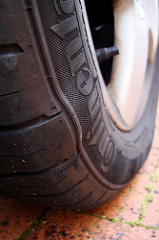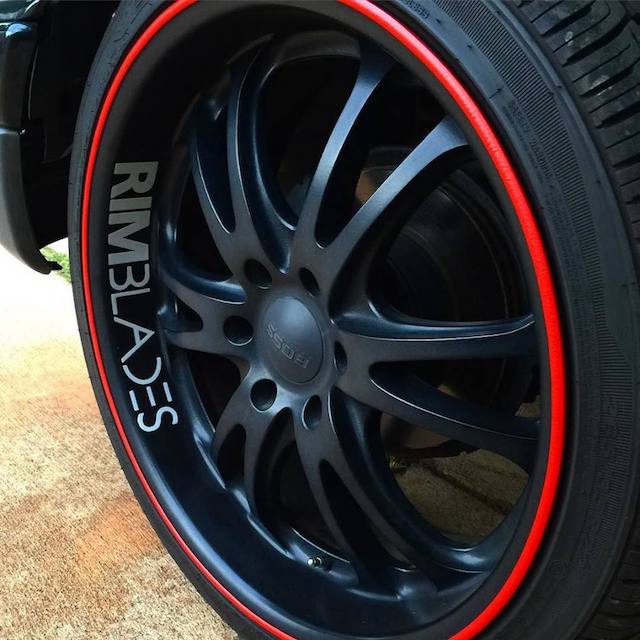Curb Rash Wheel Repair Costs – What To Expect
Whether you’ve misjudged your space to parallel park or bumped a curb to avoid hitting something else, your wheel may have suffered curb rash. Once you’ve given the damage a quick visual inspection, you’ll want to plan your next moves. If one of your wheels has scraped a curb and suffered damage, here’s what to expect.
First, Check For Possible Tire Damage

A bulging sidewall. Image copyright warrenski.
First and foremost, consider your safety and the safety of your passengers. If the tire is severely damaged, don’t try to drive on it. Look carefully at the tire’s sidewall and check for damage:
- A bulge or blister in the sidewall indicates serious damage to the structure of the tire. If you see this, drive carefully to your local tire store, as replacement is needed.
- Scuffs and scratches may only be superficial, but it’s a good idea to get them looked at by a tire professional as soon as possible.
- Tears in the sidewall of your tire – or gouges that have removed rubber – are usually a big concern. The sidewall is often the weakest part of any tire, so you can’t ignore even small damage.
- Any damage near the bead of the tire can cause the tire to “pop” off your rims, so if you see something, drive carefully to the tire store.
Generally speaking, tire sidewall damage often requires tire replacement. Still, tires are pretty tough, so unless some speed was involved, a curb shouldn’t do much more than scuff the rubber.
Estimating Rim Damage Repair Costs
More often than not, the rims take the brunt of curb-car encounters. The type of rims you have and the extent of the damage are the two factors that will determine the cost of repair or replacement. The more exotic or upscale the rim, the more a repair is going to cost.
The Four Main Types Of Rims
Understanding the type of rim you have is important if you’re going to estimate the cost of repairing any curb damage.
- Steel wheel rim. Steel is durable and can withstand a lot of damage. If you have steel rims that are bent, try taking them to a professional for repair. Usually, they can be fixed.
- Chrome-plated wheel rim. Curb damaged chrome wheels may require sandblasting and re-plating, which is generally quite expensive. Often times, it’s more cost-effective to buy a replacement chrome rim.
- Aluminum alloy wheel rim. Produced from an alloy of aluminum, these rims are commonly offered on new vehicles. They are usually painted, and often have clear coat as well. If they’re bent, it is often difficult to fix them safely. If they’ve been scratched or scuffed up, they can be sanded and repainted.
- Plastic-clad wheel rims. Plastic cladding often looks like chrome, but it’s much lighter (and cheaper) for the manufacturer. Unfortunately, it’s typically not possible to repair plastic that’s been damaged. Instead, you can either replace the entire wheel, or try to remove and replace the plastic cladding (which isn’t always possible).
Summing up: If you’ve got an alloy wheel, you’re looking at sanding and repainting. If you’ve got a chrome wheel, you’re looking at re-plating or replacing. If you’ve got a plastic-clad wheel, you’re probably doing replacement only. And if you’ve got steel? You can just bend it back, paint it, and be on your way.
Typical Rim Repair Costs
The table below will help you figure out how much a rim repair will cost.
| Type of Rim | Wheel Is Scratched or Scuffed | Wheel Is Bent | Wheel Is Gouged or Cracked |
|---|---|---|---|
| Steel Wheel | $50-$150 for sand, putty, and paint, only many people don’t bother to fix scratches and scuffs on steel wheels | If bending back the wheel weakens the metal, welding may be required for $50-$100. Otherwise, bending the rim can be $50 or less | Steel wheels can’t really crack, but a gouge will usually require replacement |
| Aluminum/Alloy Wheel | $50-$150 for sand, putty, and paint. Original color can be difficult to match. | Bent alloy wheels usually can’t be repaired safely, so replacement is often required. | A cracked or gouged alloy wheel should be replaced in almost all cases. |
| Chrome Wheel | Repairing damage and then re-plating can cost upwards of $500, and typically no less than $200. For this reason, chrome wheels are usually just replaced if they’ve been scratched or scuffed. | Most chrome-plated wheels are steel underneath, and can be bent back for a small fee ($50-$100). However, bending them will often damage the finish. If the wheel is aluminum (not common), then bending them likely isn’t safe to do. | A cracked or gouged chrome wheel will usually be replaced if at all possible. Otherwise, the cost to repair and then re-plate the wheel will be eye watering. |
| Plastic clad wheels | There aren’t any good ways to repair plastic, so plastic clad wheels are usually replaced. The only question is, can the cladding be replaced, or does the entire wheel need to be replaced? | A bent plastic clad wheel probably has a big chip in it and/or the plastic has shattered. Replacing the cladding is required, which often means an all new wheel. | Gouged or cracked plastic cladding can not be repaired. Replacement is usually the only option. |
But What About Repair Kits?
If you have an aluminum alloy wheel with light scratches or scuffing, there are DIY repair kits available for $30-$50. However, a few things to keep in mind:
- These kits are only as good as the user. If you don’t have much experience with sanding down metal, applying putting, sanding that down, and then applying a finish, you might not be happy with the result.
- Paint color is often difficult to match.
- Clearcoat wheels can’t usually be repaired with a kit.
Finally, don’t forget to account for the cost of your time when considering a DIY rim repair kit…check out our article about DIY rim repair for more information.
The Best Way To Save Money – Prevent Curb Rash

Aside from unrealistic preventative measures, like never parallel parking or controlling all outside forces of traffic, there are other options to save your rims and prevent the high cost of curb rash repairs.
RimBlades and RimSavers were created to improve the appearance of your vehicle and save you money. RimBlades stick to your alloy wheels and conform to protect easily. RimSavers provide an even higher level of durable protection and are also easy to install.
Both products are available in a variety of colors and enhance the look of your car. As you can see, paying $49.99 to $79.99 to protect all your wheels is definitely cheaper than repairing a damaged rim.






